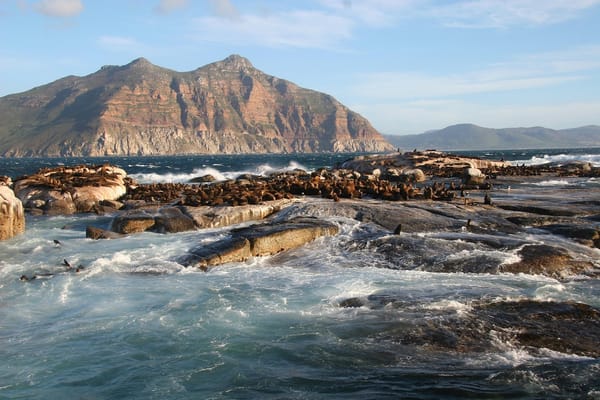Monday☕️

Weekend Recap:
- On August 22, 2025, the U.S. Justice Department released transcripts from a two-day interview with Ghislaine Maxwell, conducted by Deputy Attorney General Todd Blanche as part of ongoing reviews related to her association with Jeffrey Epstein. The interviews granted Maxwell limited immunity to facilitate discussion and centered on her knowledge of Epstein's activities and interactions with prominent individuals. In the transcripts, Maxwell indicated she had not observed any inappropriate behavior by figures such as former President Donald Trump or former President Bill Clinton, characterizing Trump as "a gentleman in all respects" in their interactions and denying knowledge of any Epstein "client list" or blackmail materials.
- On August 24, 2025, SpaceX successfully launched the CRS SpX-33 mission from Space Launch Complex 40 (SLC-40) at Cape Canaveral Space Force Station in Florida, using a Falcon 9 Block 5 rocket at 2:45 a.m. EDT (0645 UTC). This marked the 33rd Commercial Resupply Services mission to the International Space Station (ISS), aimed at delivering essential supplies, scientific investigations, and hardware to support ongoing research and operations aboard the orbiting laboratory. The payload consisted of a Cargo Dragon spacecraft carrying approximately 6,000 pounds of cargo, including food, crew provisions, advanced scientific experiments in areas such as biotechnology and materials science, and notably, a new boost module housed in the Dragon's trunk designed to assist in raising the ISS's orbit for the first time in this series of missions. The spacecraft has autonomously docked with the ISS on August 25, and will remain attached for about a month before returning to Earth with research samples and other items.
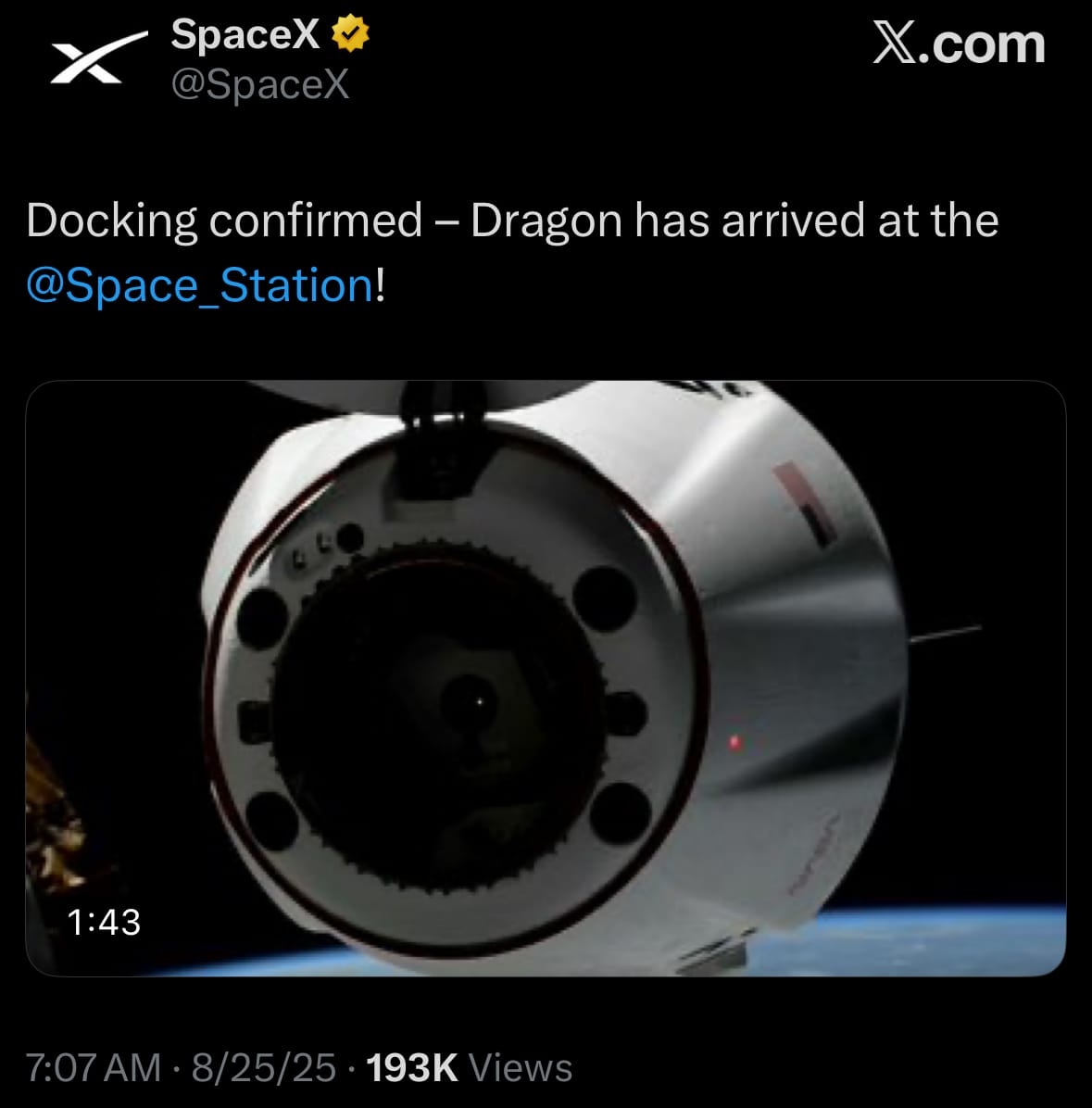
- On August 24, 2025, Rocket Lab successfully launched the "Live, Laugh, Launch" mission from Launch Complex 1A (LC-1A) at the Māhia Peninsula in New Zealand, using an Electron rocket equipped with a Curie kick stage at 10:42 a.m. NZST (22:42 UTC on August 23). This marked the company's 12th launch of 2025 and the 70th overall for the Electron vehicle, dedicated to deploying satellites into a sun-synchronous low-Earth orbit for commercial purposes. The primary payload was the EchoStar Lyra-2 satellite, a 74-kilogram spacecraft manufactured by Astro Digital for EchoStar Global Australia as part of a four-satellite Block 1 constellation designed to provide global Internet of Things (IoT), machine-to-machine (M2M), and other data services. The mission also carried four additional confidential payloads, with all satellites successfully separated and deployed following a nominal ascent and multi-burn sequence by the Curie stage.
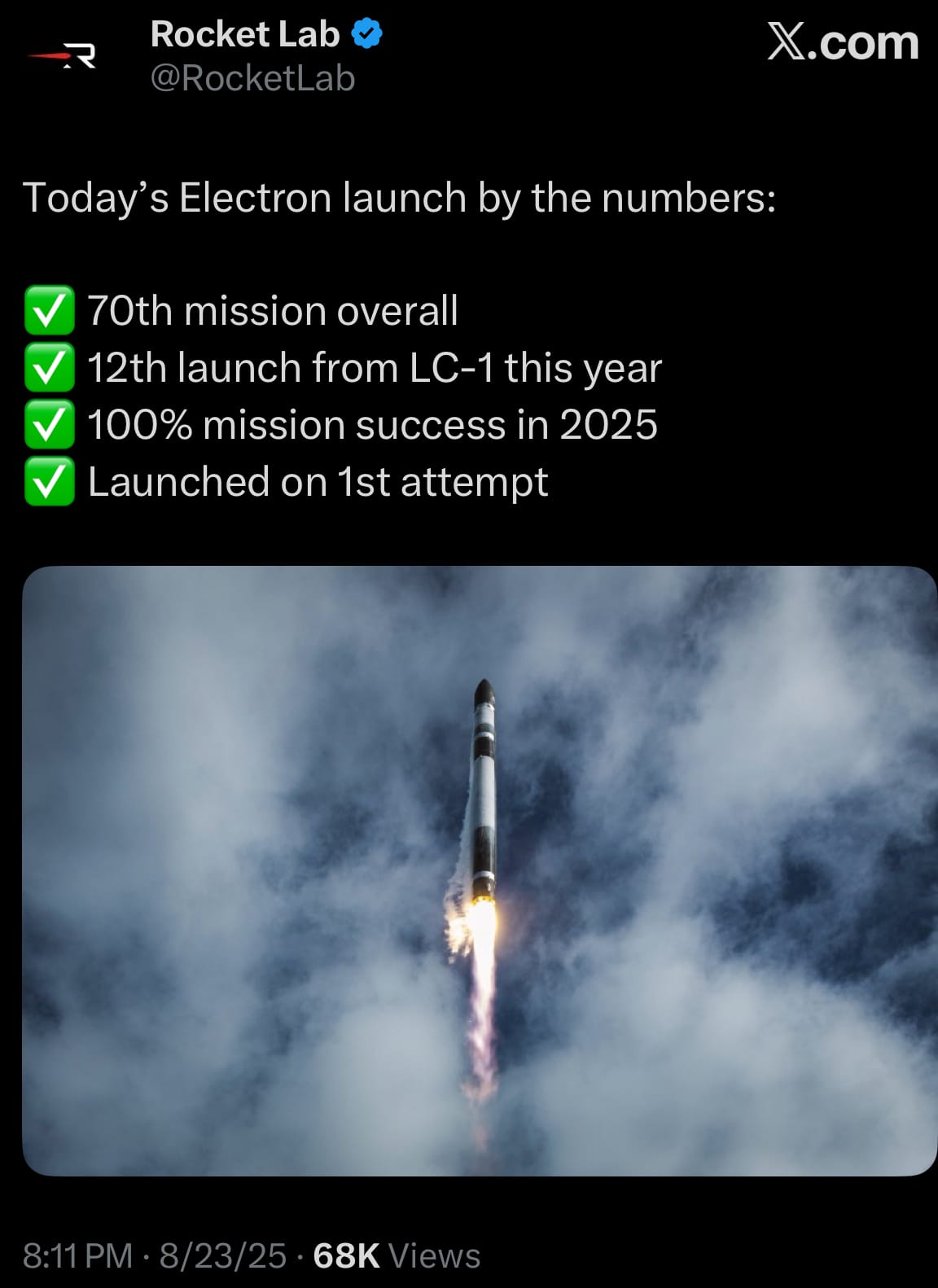
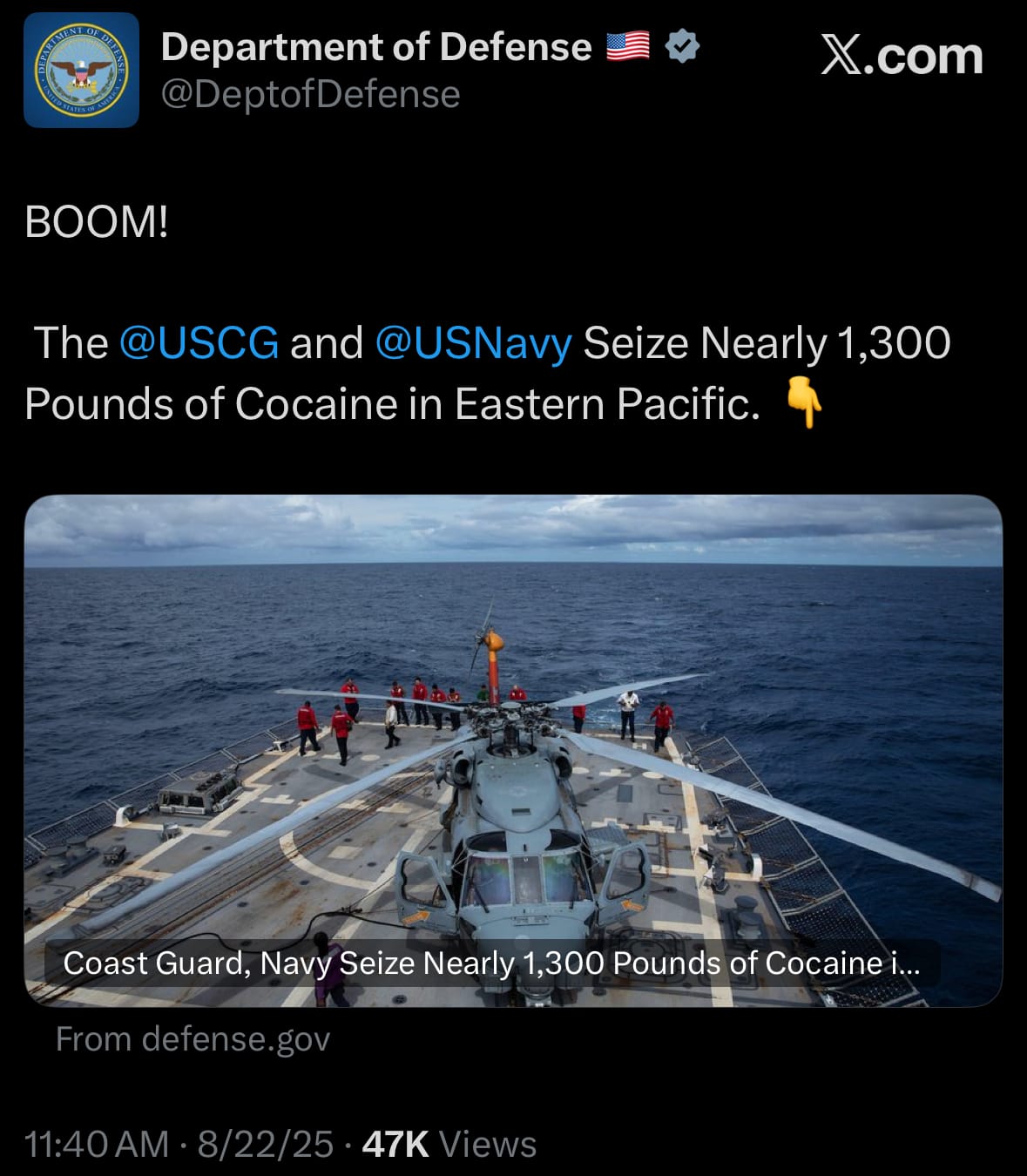
Economics & Markets:
- Today’s commodity market:

- Today’s crypto market:

Geopolitics & Military Activity:
- As of August 24, 2025, the amphibious transport dock USS San Antonio (LPD-17) has departed from Naval Station Norfolk, Virginia, heading toward waters off the coast of Venezuela. This follows a brief port stay to avoid Hurricane Erin, with the ship now joining other units of the Iwo Jima Amphibious Ready Group, including the USS Iwo Jima (LHD-7) and USS Fort Lauderdale (LPD-28). The U.S. describes the deployment as a counter-narcotics effort aimed at disrupting drug trafficking networks allegedly linked to Venezuelan entities, occurring amid heightened diplomatic tensions between the U.S. and the Venezuelan government under President Nicolás Maduro. The U.S. has also announced an increased bounty of $50 million for information leading to Maduro's arrest related to these allegations.
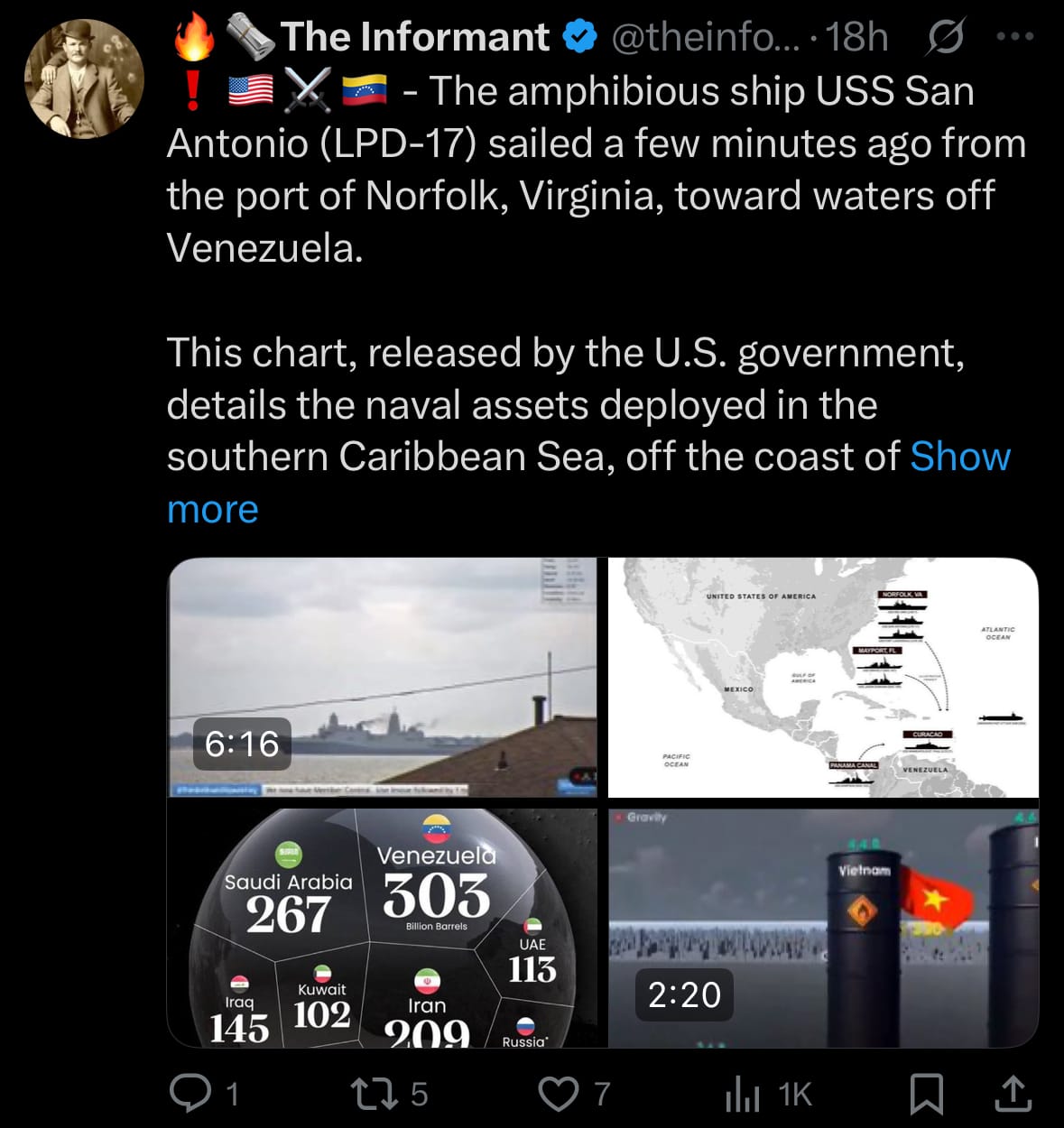
- A chart released by the U.S. government outlines naval assets in the southern Caribbean Sea, including three Arleigh Burke-class guided-missile destroyers (USS Sampson, USS Gravely, and USS Jason Dunham), one Wasp-class amphibious assault ship capable of operating F-35B aircraft, two San Antonio-class amphibious transport docks, one Littoral Combat Ship, and a nuclear-powered attack submarine. This deployment involves around 4,000 troops and supporting aircraft like the P-8 Poseidon, marking a significant U.S. military presence in the region for stated counter-narcotics purposes, while also serving as a potential strategic response to regional instability. Venezuela possesses the world's largest proven oil reserves, estimated at over 300 billion barrels, which contributes to its geopolitical significance amid ongoing international sanctions and disputes.
Environment & Weather:
- On the evening of August 24, 2025, massive flooding occurred in the Pico area of La Trinidad, Benguet, Philippines, triggered by heavy rainfall associated with the southwest monsoon and Tropical Storm Isang, with floodwaters rapidly rising around 5:00 PM in Lower Bayabas and turning roads into rivers of muddy water. The flooding inundated major thoroughfares such as Buyagan National Road, disrupting traffic between Baguio City and Benguet, and affected access roads to nearby barangays, as captured in videos showing swift currents sweeping through residential and commercial zones.

- Local authorities monitored waterways and deployed response teams, with no immediate reports of casualties in the area, though the event contributed to broader impacts affecting over 50,000 people across the country due to ongoing weather conditions, prompting declarations of states of calamity in some regions and calls for enhanced disaster preparedness.

Statistic:
- Largest assets on Earth by market capitalization:
- Gold: $22.931T
- 🇺🇸 NVIDIA: $4.340T
- 🇺🇸 Microsoft: $3.770T
- 🇺🇸 Apple: $3.380T
- 🇺🇸 Alphabet (Google): $2.495T
- 🇺🇸 Amazon: $2.440T
- Bitcoin: $2.214T
- Silver: $2.181T
- 🇺🇸 Meta Platforms: $1.896T
- 🇸🇦 Saudi Aramco: $1.534T
- 🇺🇸 Broadcom: $1.382T
- 🇹🇼 TSMC: $1.208T
- 🇺🇸 Tesla: $1.096T
- 🇺🇸 Berkshire Hathaway: $1.055T
- 🇺🇸 JPMorgan Chase: $814.58B
- 🇺🇸 Walmart: $772.74B
- 🇨🇳 Tencent: $707.51B
- 🇺🇸 Visa: $679.40B
- 🇺🇸 Oracle: $663.92B
- 🇺🇸 Eli Lilly: $637.99B
- 🇺🇸 SPDR S&P 500 ETF Trust (SPY): $592.25B
- Ethereum: $555.46B
- 🇺🇸 Mastercard: $541.46B
- 🇺🇸 Netflix: $511.88B
- 🇺🇸 Exxon Mobil: $474.41B
History:
- Stealth technology, often referred to as “low observable technology,” traces its origins back to theoretical work during the Cold War. The idea of reducing radar cross-sections to make aircraft less detectable emerged in the 1950s and 1960s, shaped in part by the research of Soviet physicist Pyotr Ufimtsev, whose equations on electromagnetic wave reflection were later exploited by U.S. engineers. Lockheed’s Skunk Works team applied these principles in the 1970s, resulting in the F-117 Nighthawk, the world’s first operational stealth aircraft. This breakthrough was followed by further advances in radar-absorbing materials, faceted and blended aerodynamic designs, and revolutionary platforms such as the B-2 Spirit bomber, cementing stealth as a central component of modern airpower.
- Since then, the United States has maintained an overwhelming dominance in stealth technology. Other nations, including Russia with the Su-57 and China with the J-20, have made strides in stealth aircraft development, but the U.S. remains unmatched in the scale, operational readiness, and sophistication of its stealth fleet. With platforms like the F-22 Raptor and F-35 Lightning II—supported by decades of R&D, advanced materials science, and tightly integrated defense-industrial expertise—the U.S. has expanded stealth beyond aircraft into naval vessels, drones, and future systems. Today, stealth stands as a defining pillar of American military strategy, enabling global power projection and securing a decisive edge in contested environments.
Image of the day:

Thanks for reading!
Earth is complicated, we make it simple.
Click image to view the Earth Intelligence System:



Support/Suggestions Email:
earthintelligence@earthintel.news


